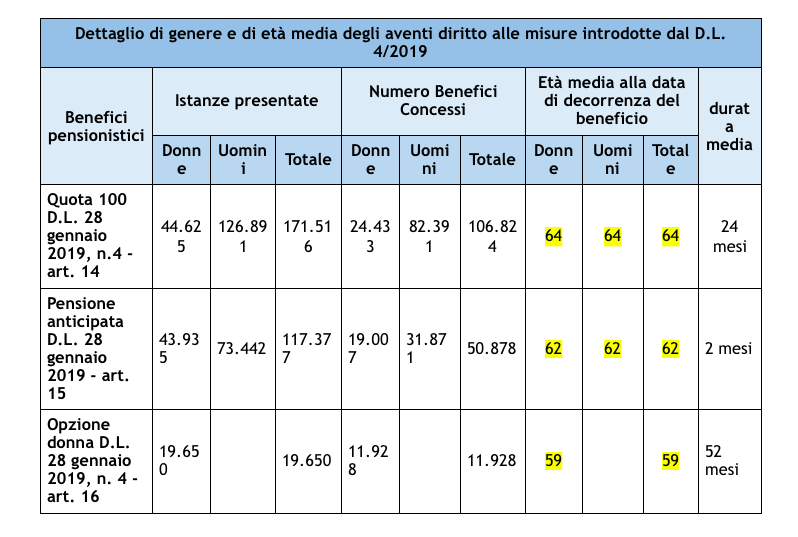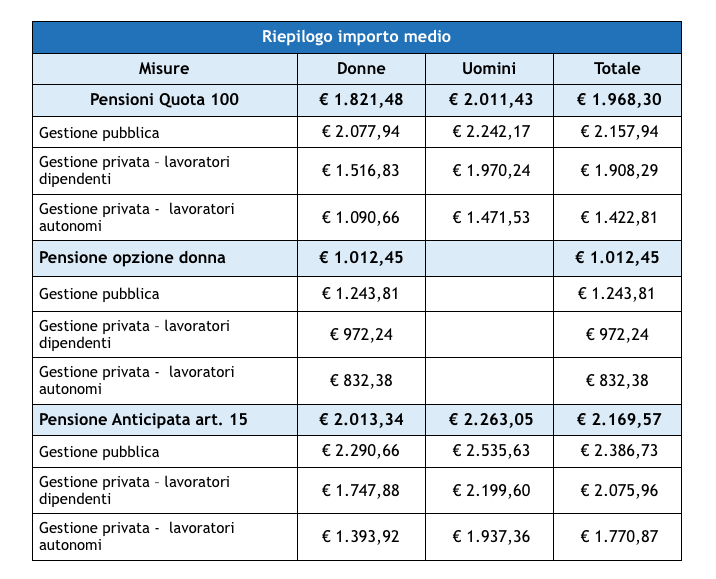“Data which, overall, therefore certify the stability of the system, at least until 31 December 2018: however, the impact of Quota 100 still needs to be evaluated both on the total number of pensioners and on the delicate and fundamental active/retired ratio”. These are the concluding considerations of the press release with which, in recent days, the authoritative Social Security Itineraries Study Center announced the forthcoming presentation of the seventh report on pension expenditure. Basically, according to Albero Brambilla's think tank, the system is holding its breath waiting for the effects of the measures launched by the yellow-green government to be summed up and inherited, without saying boo, from the executive chaired by Giuseppe(i) Conti (with the number 2 stamped on the pouch). So the problems remained, both in the present and in perspective. Let's see why. Processing the INPS monitoring data on the counter-reform measures - in the field of social security and assistance - contained in the ''decree of the two flags'' (dl n.4/2019) of the Conte 1 government, emerge interesting aspects practically ignored by the debate which led to the exclusion of abolitions or modifications in the budget law. Yet it would be enough to observe the two tables that are published in this article with a modicum of intellectual honesty.
Table 1. Applications received and accepted - details of gender, average age and average duration of the three measures introduced by Decree Law 4/2019 converted into Law 26/2019

Table 2. Accepted applications - details of the average amount by management and by gender of the three measures introduced by Decree Law 4/2019 converted into Law 26/2019

Let's examine, one by one, the themes.
The discussion on quota 100 was objectively propaganda because it is aimed at ''cutting'' the measure best known to public opinion and debated to exhaustion on talk shows. As is known, this is an experimental and three-year derogation, which allows you to bring forward the seniority treatment by asserting (the requisites are fixed and both necessary) at least 62 years of age and 38 years of contributory seniority. The fact is that the confrontation within the majority ignored (out of ignorance or opportunism?) another measure contained in the decree: the block until the end of 2026 at 42 years and 10 months of service (one year less for women) than ordinary retirement regardless of age (according to the rules of the Fornero reform). In short the automatic increase in requirements has been suspended until 1 January 2027 as a result of the dynamics of life expectancy. Therefore, even if quota 100 had been abolished (a deserving and wise thing) leaving the other way out anticipated unchanged for a fair number of years, the government would have confined itself to closing a window and leaving the door open.
But the best is yet to come. The data proves that generations of the baby boomers, who started working early and on a stable and continuous basis, are not tied to the 100 quota, because they can use ordinary early retirement now with the requirements blocked. And they are able to do so (see table 1) at an effective average age (62 years) lower than the equally average and effective age (64 years) of the ''quotacentisti''.
It will be said that the average data follow Trilussa's philosophy, but there is no other way to make considerations of a general nature, especially since the monitoring tables summarize concrete cases of applications presented and accepted. The same argument also applies to the average monthly amounts of the treatments provided. We can thus establish how much does a pensioner at 100 cost the system, considering the months in advance he enjoyed. If the average duration of the advance is equal to 24 months (tab.1) it is sufficient to multiply the average amount of the treatment by this number (tab.2). In the case of an employee we can round, for all types, to 2 gross per month which becomes 48 in relation to the average duration of the advance. Of course, over time there will be a recovery because the pension allowance will discount the lower initial amount. But in the three-year period of experimentation that is the effective ''cost'' of a ''quotacentista''. The operation can be repeated for other types of retirement. It is interesting to note that in the case of the women's option, the months in advance (effective, we repeat) become 52.
Finally, sooner or later it will be necessary to understand what the “rules of engagement” will be", in force at the conclusion of the trial period, when - rebus sic stantibus – we will return to the Fornero regime. Here is a too high ''staircase'' appearing on the horizon. In this way – by inciting public opinion as is usual – the conditions will be created for demand a downward structural revision of retirement requirements, throwing upside down all the forecasts on the decreasing incidence of pension expenditure on the GDP elaborated in recent years, with the sound of reforms. When one comes across a step higher than the others, however, the solution cannot be just to lower it (as the Prodi government did in 2007). It would be more virtuous to create a harmonious ascent path, raising the previous steps as necessary. And this is exactly what, at least for now, the government has avoided doing.





